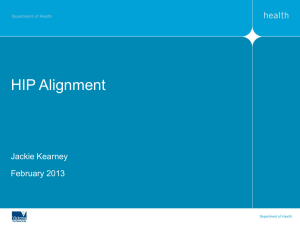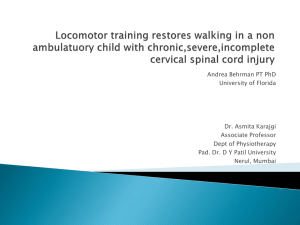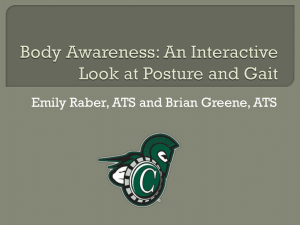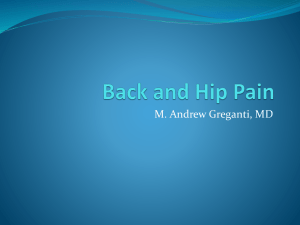Life Without Hip Precautions - College of Occupational Therapists
advertisement
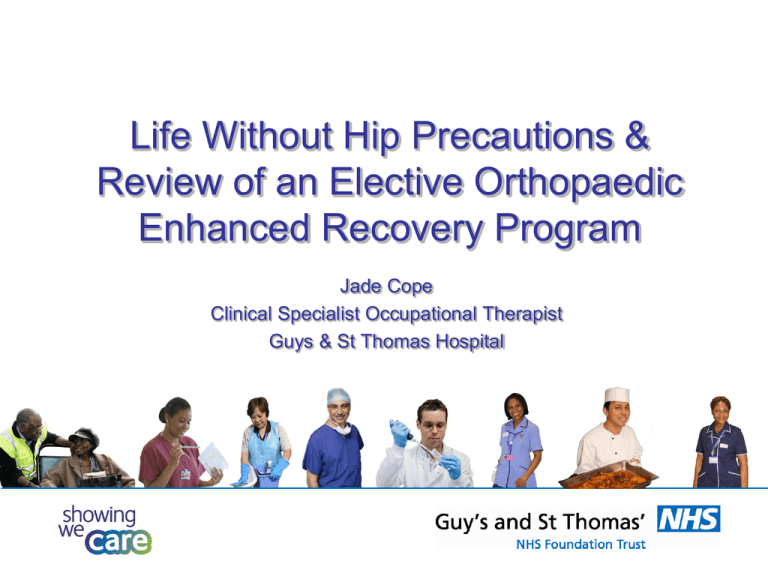
Life Without Hip Precautions & Review of an Elective Orthopaedic Enhanced Recovery Program Jade Cope Clinical Specialist Occupational Therapist Guys & St Thomas Hospital Hip precautions are not routinely implemented within Guys and St Thomas Trust for elective and trauma patients receiving total, hemi or revision hip replacement surgery. This has been standard practice since March 2011. Why? • Extensive MDT discussion and service review • Limited evidence base to support use of hip precautions • Introduction of enhanced recovery programme National Figures No. hip replacements 2012 % antero-lateral approach % posterior approach 86,488 33% 61% • Average LOS for elective THR is 5 days, 15.7 days for patients following hip fracture (National Joint Registry, 2013) • The use of hip precautions varies nationally, lack of direction and evidence base (Drummond et al, 2012) Reasons for OT’s implementing hip precautions (Drummond et al, 2012, pg. 5) Response Yes (%) No (%) Missing (%) Surgical approach 42.5 56.9 0.6 Surgical opinion 72.4 27.0 0.6 Hospital policy 28.7 70.0 0.60.6 Occupational Therapy Policy 53.4 46.0 0.6 Team decision 40.8 58.6 0.6 Evidence base 21.8 77.6 0.6 Reduce length of stay 9.6 90.2 0.6 Other 12.1 86.8 0.6 Reasons for Hip Dislocation • Multiple factors e.g. surgical approach, component mal-position and Soft tissue imbalance (Malik et al, 2002) Study identified reasons for 24 dislocations following THR: 11 due soft tissue imbalance, 5 malposition of acetabulum implant, 3 exaggerated posterior tilting of pelvis, and 5 multifactorial (Kawano et al, 2013) • Higher incidence in posterior approach compared to anterior (SIGN,2009) Surgical Approach and Dislocation Rate Anterior Approach • • • • Front of the joint Smaller incision Muscle splitting approach Lower dislocation rate Posterior Approach • Back of the joint • Often removes and reattaches muscle • Studies suggest posterior dislocations account for 80-95% of dislocations (Davenport, 2012) Advancements in surgical procedure • The National Joint Registry for England and Wales has highlighted a statistically significant increase in the use of femoral head size (>36mm) from 5% 2005 to 26% 2009 (NJR, 2013) Larger femoral head size ie >36mmreduces risk of dislocation compared to smaller ie 28mm after THR (Kostensalo et al (2013) • The dislocation rate has decreased from 1.25% in 2005 to 0.96% in 2009 (Jameson et al, 2011) The research summarised… Lack of robust evidence to support/reject the use of hip precautions following THR Limited research into the use of precautions for revision surgery and for THR in trauma patients Existing guidelines suggest hip fractures are unnecessary following hemiarthroplasty via an anterolateral approach (BOA, 2007) Lack of direction and consensus amongst OTs on the use of hip precautions (Drummond, 2012) Occupational therapy for adults undergoing total hip replacement: Practice guidelines Published in 2012 to guide OT practice (COT, 2012) “It is suggested that due to uncertainty surrounding the need for hip precautions and the potential for an increase in satisfaction and early functional independence when hip precautions are relaxed or discontinued, occupational therapists engage in local discussion/review of the emerging evidence with their surgical and multidisciplinary teams” (COT, 2012 pg51) GSTT current practice • 445 elective and 230 trauma hip replacements in 2013 • Largely use cement-less fixations with ceramic on ceramic prosthesis • Range of approaches to suit patient • OT practice guided by operative note Impact of removing precautions on OT practice Coole et al (2013) looked at OT clinicians perspectives on relaxing precautions following hip replacement: • Relaxing hip precautions would likely benefit patients i.e. reduced anxiety and LOS • Concerns over loss of jobs and role for OT • Some felt it would allow time to treat more to address other occupations eg work related Impact on OT role at GSTT Pre Assessment Hospital Ward Discharge home • Increased clinical reasoning; less prescriptive equipment provision • Greater need for qualified staff • ‘Joint school’ patient education • Occupation focused functional assessment • Reduced delay due to equipment • Equipment provision for comfort and safety – 40% increase activity with same budget • Rehabilitation on trauma wards within short acute ward LOS • Introduction of Guys Orthopaedic Outreach Team • Reduced LOS; 2.7 in elective and 12 in trauma • Increase from 15% to 60% trauma patients home independent without social services Hip precautions and anxiety “…because I feel very good now, the hardest part is remembering what I can’t do” Dave NHS choices “She's frightened to death that she won't cope (can't have a bath, can't bend down to put the TV on etc) and I'm extremely concerned about her welfare” Claire NHS choices Data Collection at GSTT • To observe the dislocation rate after 12weeks following THR, hemiarthroplasty or revision surgery for all trauma and elective patients • Recording the surgical approach • If hip precautions prescribed • Phone call at 12 weeks Preliminary Data • 1.6% of elective and 4% of trauma patients have been prescribed hip precautions since data collection began in April 2013 • Of the 328 patients who have been contacted, two have dislocated • Both elective without precautions, one on table and the other at two weeks post op • Aim to complete data collection for 400 patients by August In conclusion… • GSTT have found no increase in dislocation rate since ceasing to implement standard hip precautions in 2011 for THR, hemiarthroplasty and revision surgery • Lack of robust evidence to support their use • Variation in OT practice nationally • Advice to implement COT practice guidelines recommendations and speak to MDT re use of hip precautions in your area YES! We think there is a life without hip precautions (But it must be consultant lead) References • • • • • • • • British Orthopaedic Association, British Geriatrics Society. (2007)The Care Of Patients with Fragility fractures. London: BOA College of Occupational Therapists, Specialist Section Trauma and Orthopaedics (2012) Occupational Therapy for adults undergoing total hip replacement: Practice guideline. COT: London Coole, C., Edwards, C, Brewin, and Drummond A (2013) What do clinicians think about hip precautions following total hip replacement? The British Journal of Occupational Therapy: London. 76(7 300-307 Drummond A, Coole C, Brewin C, Sinclair E (2012) Hip precautions following primary total hip replacement: a national survey of current occupational therapy practice. British Journal of Occupational Therapy, 75(4), 164-70. Davenport, M (2012) Joint Reduction, Hip Dislocation, Posterior, Medscpare Reference: Drugs diseases and Procedures. Available at www.emedicine.medscape.com Accessed on 01/11/13 Fox, R., Halliday, R., Barnfield, S., Roxburgh, J., Dunford, J and Chesser, T (2011). Hip precautions after hemiarthroplasty: what is happening in the UK and at what cost? The Royal College of Surgeons of England 93(5) 396-397 Jameson, S., Lees, D., James, P., Serrano-Pedraza, I., Partington, P., Muller, S., Meek, R and Reed, M (2011) Lower rates of dislocation with increased femoral head size after primary hip replacement: a five year analysis of NHS patients in England. The Bone and Joint Journal, 93(7) 876-880. Kawano, S., Sonohata, M., Takayama G., Tsukamoto, M., Kiajima, M and Mawatari, M. Revision Total Hip Arthroplatsy for recurrent dislocation. The Bone and Joint Journal 2013. vol. 95-B no. SUPP 15 214 • • • • • • Malik, M, Lovell, M, Jones, M (2002) Patient-related Factors leading to Total hip Replacement Dislocation: A Case Series. Advances in Physiotherapy: Taylor & Franics, (4), 85-86 National Joint Registry (2013) National Joint Registry for England Wales and Northern Ireland 10th Annual Report. Hemel Hempstead: NJR Available at www.njrcentre.org.uk NHS Choices Department of Health www.nhs.co.uk/conditiond/Hip-repacement Accessed on 28/10/13 Restrepo C, Mortazavi SMJ, Brothers B, Parvizi J, Rothman R (2011) Hip dislocation: are hip precautions necessary in anterior approaches? Clinical Orthopaedics and Related Research, 469(2), 417– 422. Scottish Intercollegiate Guidelines Network (2009) Management of hip fracture in older people. A national clinical guideline Number 111. Edinburgh: SIGN Stewart, L & McMillan, I (2011) How necessary are hip restrictions for avoiding dislocation following hemiarthroplasty or total hip arthroplasty in older patients with a hip fracture? The British journal of Occupational Therapy, 74(3) 110-118 Accelerated Discharge Program - Elective • • • • Guys Hospital Primary and revision hip and knee replacements Redesign of old pathway Introduction of interdisciplinary extended scope rehab outreach team (GOOT) • Aim Discharge day 2 hips, day 3 knees • Commenced June 2013 Opportunity for change at GSTT • In 2010 • Previous LOS Hips 5.5 days and knees 6.4 • Pressing need to improve efficiency and patient • • • • experience. Wait for surgery 9- 12 months Predicted 60% increase in throughput with no bed increase Make it happen! Enhanced recovery – difference for all services GSTT ERP….What changed…..? • • • • • • • 7DW – joint MDT Rota Mandatory attendance at Pre-op Education Class (hips and knees) Education Class MDT (Physio, OT & Nursing) All hips and knees seen by OT in PAC Written Patient information PAC Access to electronic patient information – website OT PAC – home set up and negotiation of having carer stay post op. • Guys Orthopaedic Outreach Team (GOOT) input if eligible • Extended scope – GOOT (Physio, nursing & OT competencies) Guys Orthopaedic Outreach Team • Eligibility - Geographical location Support at home Home environment set up Patient consent • Eligibility - Geographical location Support at home Home environment set up Patient consent GOOT Home Rehab Goals • • • • • • Progress Mobility Stairs Knee and hip Joint range Functional transfers Equipment provision Wound dressings • Observations taken each visit, documentation on IPAD Ap. Outcomes • • • 1 year later 1000 plus patients through pathway Fantastic patient feedback Staff satisfaction improved, greater interest in orthopaedics due to extended scope • LOS now Hips GOOT 2.4 NON GOOT 4.4 average all 3.4 Knees GOOT 3.3 and NON GOOT 5.9 average all • Wait for surgery – 1 week. Contracting other trust wait lists. GOOT Specific • Nil SSI or dislocations • X 1 readmission • Most don’t need visits – now aiming for day 1 hips and 2 knees. Either home on time meeting milestones or unwell Other influencing factors…… • Hip Precautions • Anesthetic protocols • GPs educated and giving more accurate information • Advancements in surgery technique / prosthetics


